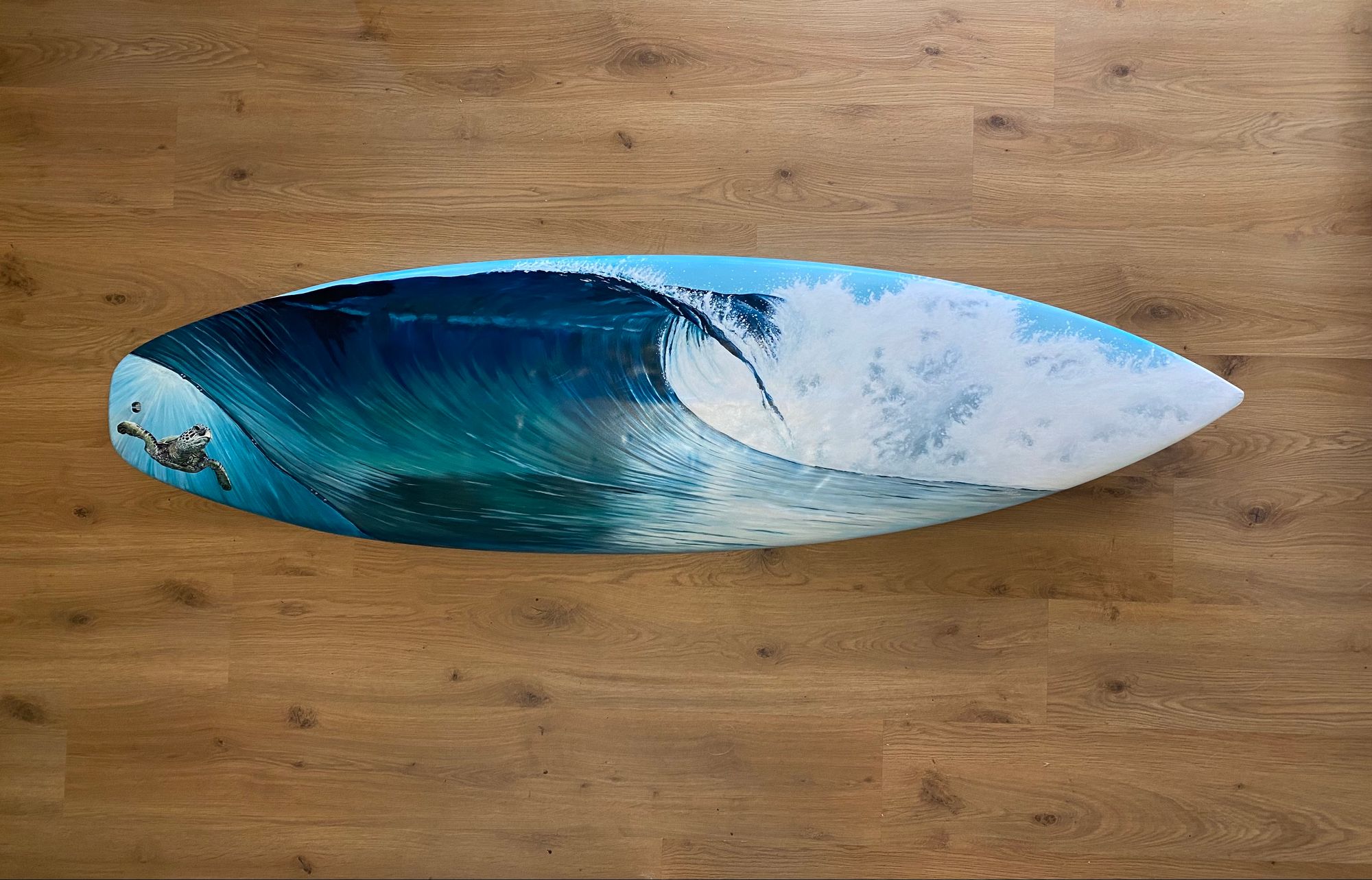Exploring the Future of Surfboards: A Deep Dive into Sustainable Options

Surfing is an exhilarating sport that allows us to connect with nature and the ocean. However, what many of us don't realize is the significant impact that surfing can have on the environment. As surfers, we should be aware of the footprint we leave behind and strive to minimize our impact on the ocean - the very essence of our beloved sport.
The environmental impact of surfing comes from various sources, including the materials used to make surfboards, the waste generated during the production process, and the way we dispose of our boards when they are no longer usable. Additionally, our choices in accessories, gear, and even the way we travel to surf spots can have a significant impact on the environment.
The Importance of Sustainable Surfboards
As surfers, we have a responsibility not only to enjoy our sport but also to protect the environment that makes it possible. Sustainable surfboards are a key part of this effort, as they help reduce the environmental impact of surfing and promote a more eco-friendly approach to the sport. By choosing sustainable surfboards and gear, we can minimize our carbon footprint, reduce waste, and promote a more sustainable surfing culture.
Sustainable surfboards are made from eco-friendly materials that have a lower environmental impact than traditional materials. They can be designed to last longer, reducing the need for frequent replacements and lessening the waste generated by discarding broken or outdated boards. Furthermore, sustainable surfboards often use production processes that minimize the release of harmful chemicals into the environment.
By supporting sustainable surfboard manufacturers and brands, we can drive innovation in the industry and encourage other companies to adopt more environmentally friendly practices. This collective effort can help preserve our oceans and beaches for future generations of surfers and marine life.

Traditional Surfboard Materials and Their Environmental Impact
Traditional surfboards are typically made from a combination of materials, including polyurethane foam, polyester resin, and fiberglass. While these materials have allowed for the development of high-quality, lightweight boards, they also have significant environmental impacts.
Polyurethane foam is a petroleum-based product and its production generates a considerable amount of greenhouse gas emissions, contributing to climate change. Additionally, the foam contains toxic chemicals, such as toluene diisocyanate, that can be harmful to both humans and the environment.
Polyester resin, another petroleum-based product, is used to coat the surfboard, providing a durable and waterproof finish. However, the production of polyester resin generates hazardous waste and releases volatile organic compounds (VOCs) into the atmosphere. These VOCs contribute to air pollution and can have detrimental effects on human health.
Fiberglass, a material made from thin strands of glass, is used to strengthen the surfboard. While fiberglass itself is not particularly harmful to the environment, the production process can generate waste and consume large amounts of energy. Additionally, fiberglass can be difficult to recycle, often ending up in landfills when surfboards are discarded.

Innovative Sustainable Surfboard Materials
In response to the environmental impact of traditional surfboard materials, several innovative and sustainable alternatives have been developed. These eco-friendly materials not only reduce the environmental impact of surfboard production but also help create boards that perform just as well, if not better, than their traditional counterparts.
One such material is expanded polystyrene (EPS) foam, which is a more sustainable alternative to polyurethane foam. EPS is an easily recyclable material and has a lower greenhouse gas emission profile compared to polyurethane. Additionally, EPS can be combined with other sustainable materials, such as recycled foam or plant-based alternatives, to create even more eco-friendly surfboard cores.
Bio-based resins are another sustainable alternative, replacing petroleum-based polyester resins with materials derived from plants, such as soy or algae. These bio-resins not only have a lower carbon footprint but also release fewer VOCs during the production process, reducing air pollution and potential health risks.
Flax, hemp, and basalt fibers are eco-friendly alternatives to fiberglass, offering comparable strength and durability without the environmental drawbacks associated with traditional fiberglass production. These natural fibers are renewable resources, and their production consumes less energy and generates less waste.
Eco-Friendly Surfboard Brands and Manufacturers
As awareness of the environmental impact of traditional surfboard materials grows, an increasing number of brands and manufacturers are adopting sustainable practices and offering eco-friendly surfboard options. Some notable examples include:
- Firewire Surfboards: This well-known surfboard brand is committed to using sustainable materials, such as EPS foam cores and bio-resins, in their boards. Firewire also focuses on reducing waste during the production process and is a member of the Sustainable Surf's ECOBOARD Project, a program that certifies surfboards with reduced environmental impacts.
- Grain Surfboards: Specializing in wooden surfboards, Grain Surfboards uses sustainably sourced wood and bio-based resins to create beautiful, high-performance boards. Wooden surfboards not only have a lower environmental impact but are also durable and long-lasting, reducing the need for frequent replacements.
- Earth Technologies: This California-based manufacturer is dedicated to producing sustainable surfboards and other watercraft. Earth Technologies uses eco-friendly materials, such as plant-based foam cores and bio-resins, and incorporates recycled materials whenever possible. The company also offsets its carbon emissions through reforestation projects and is a member of the ECOBOARD Project.
By choosing to support eco-friendly surfboard brands and manufacturers, we can contribute to a more sustainable surfing industry and help drive innovation in sustainable surfboard materials and production processes.

It's not just your board that can be more sustainable!
As surfers, we play a crucial role in promoting sustainability within our sport. By making conscious choices about the surfboards and gear we use, we can help reduce the environmental impact of surfing and encourage the industry to adopt more eco-friendly practices.
One way to promote sustainability is by choosing sustainable surfboards and gear, as discussed earlier in this article. By supporting eco-friendly brands and manufacturers, we can help drive demand for sustainable products and encourage other companies to follow suit.
In addition to choosing sustainable surfboards, we can also adopt more environmentally friendly habits in our surfing practices. This might include:
- Carpooling or using public transportation to get to surf spots, reducing our carbon footprint
- Participating in beach clean-ups and taking care of our local surf spots
- Minimizing the use of single-use plastics and other waste while surfing
- Educating ourselves and others about the environmental impact of surfing and the importance of sustainability.
In addition to sustainable surfboards, there are several eco-friendly accessories and gear available for surfers looking to minimize their environmental impact. Some examples include:
- Wetsuits: Several brands now offer wetsuits made from eco-friendly materials, such as limestone-based neoprene or plant-based alternatives like Yulex. These wetsuits have a lower environmental impact compared to traditional petroleum-based neoprene. Many companies will even recycle your old wetsuit as well!
- Surfboard Traction Pads: Many surfboard traction pads are made from petroleum-derived materials, which can be harmful to the environment. Eco-friendly alternatives include pads made from recycled materials, cork, or algae-based foam.
- Leashes: Sustainable leash options are available, made from recycled materials, such as old wetsuits or plastic bottles. These leashes not only reduce waste but also perform just as well as traditional leashes.
- Board Bags: Eco-friendly board bags are made from sustainable materials, such as recycled polyester or organic cotton. These bags provide protection for your surfboard while reducing the environmental impact associated with traditional synthetic materials.
By choosing sustainable action wherever possible, we can further reduce our environmental impact and promote a more eco-friendly surfing culture.

The Future of Surfing: Potential Advancements in Sustainability
As the surfing industry continues to evolve and grow, there is significant potential for advancements in sustainability. With increased awareness of the environmental impact of surfing and the importance of preserving our oceans and beaches, we can expect to see continued innovation in sustainable surfboard materials and production processes.
One area with potential for growth is the use of recycled materials in surfboard production. As technology advances, we may see more surfboards made from recycled foam or other materials, reducing waste and the need for new raw materials.
Additionally, advancements in bio-based materials may lead to even more sustainable surfboard alternatives, such as boards made entirely from plant-based materials or using algae-derived foam cores. These innovations could further reduce the environmental impact of surfboard production while maintaining, or even improving, the performance of the boards.
As surfers, we have the power to drive these advancements by supporting sustainable surfboard manufacturers and brands, choosing eco-friendly surfboards and gear, and adopting more environmentally friendly habits in our surfing practices.
Choosing a more Sustainable Surfboard
When choosing a sustainable surfboard, it's essential to consider several factors, including the materials used, the brand's commitment to sustainability, and the performance of the board. Here are some tips to help you find the right sustainable surfboard for your needs:
- Research materials: Familiarize yourself with the various sustainable surfboard materials available, such as EPS foam, bio-resins, and natural fibers. Look for boards that use these materials and avoid those made from traditional polyurethane foam, polyester resin, and fiberglass.
- Look for certifications: Some organizations, such as the ECOBOARD Project, certify surfboards with reduced environmental impacts. Choosing a certified board can help ensure that it meets certain sustainability criteria.
- Support sustainable brands: Research and support surfboard brands and manufacturers that are committed to sustainability, as they are more likely to use eco-friendly materials and production processes.
- Consider performance: While sustainability is important, it's also crucial to choose a surfboard that meets your performance needs. Many sustainable surfboards offer comparableperformance to traditional boards, but it's essential to find one that fits your skill level and surfing style.
- Try before you buy: If possible, try out different sustainable surfboards before making a purchase. This will allow you to get a feel for the board's performance and determine if it's the right fit for you.
By following these tips, you can find a sustainable surfboard that meets both your environmental and performance needs.

Making a Positive Change as a Surfer
As surfers, we have a unique connection to the ocean and a responsibility to protect it. By choosing sustainable surfboards and gear, adopting eco-friendly habits, and supporting sustainable surfboard brands and manufacturers, we can make a positive change in the surfing community and help preserve our oceans and beaches for future generations.
The future of surfing is bright, with significant potential for advancements in sustainability. By driving innovation in sustainable surfboard materials and production processes, we can create a more eco-friendly surfing industry and promote a more sustainable approach to the sport we love.
If your current board is beyond help, keep it out of landfill by upcycling as a coffee table, bar, outdoor shower or better yet - give it to a local artist to turn into a work of art that will last forever! I am currently taking boards destined for landfill in Perth, Western Australia, and using them as canvases to create unique art pieces that will be treasured for years. I also carbon offset every board by planting trees through Carbon Neutral in the Yarra Yarra Biodiversity Corridor in Western Australia's Mid West.
If you would like to find out more, click here to subscribe to my site and join me on my journey, reducing the amount of old surfboards that end up in landfill, one artwork at a time.
